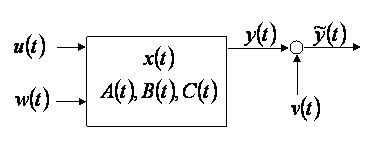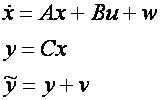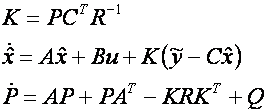An Introduction to the Kalman-Bucy Filter
The Kalman-Bucy Filter is a continuous time counterpart to the discrete time Kalman Filter. As with the Kalman Filter, the Kalman-Bucy Filter is designed to estimate unmeasured states of a process, usually for the purpose of controlling one or more of them.
Other tutorials discuss the Kalman Filter and its non-linear forms -- the Extended Kalman Filter and the Unscented Kalman Filter.

Consider the linear continuous-time process shown in Figure 1 which may be written in the following standard state-space form. (The time dependence of the parameters has been dropped to simplify the notation.)

Here
- u is the vector of inputs
- x is a vector of the actual states, which may be observable but not measured.
- y is a vector of the actual process outputs.
-
 is a vector of the measured process outputs.
is a vector of the measured process outputs. - w and v are process and output noise respectively. They are assumed to be zero mean Gaussian with covariance Q and R respectively.
Given the inputs, measured outputs and assumptions on the process and output noise, the purpose of the
Kalman-Bucy Filter is to estimate unmeasured states (assuming they are observable) and the actual
process outputs.
This is shown in Figure 2 where the estimated states are
![]() , and
, and ![]() are the estimated measured outputs.
are the estimated measured outputs.

Unlike the Kalman Filter the Kalman-Bucy filter does not use a predictor-corrector algorithm to update the state estimates. Rather it requires a differential Riccati equation to be integrated through time.
Mathematically, the filter update equations are given by

In the above equations P is an estimate of the covariance of
the measurement error and K is called the Kalman-Bucy gain.
As part of the filter implementation both
![]() and
and
![]() must be integrated through time.
Note that since P is a symmetric matrix
the number of covariance states that must be integrated may be reduced by only
considering the diagonal and terms above (or below) the diagonal.
must be integrated through time.
Note that since P is a symmetric matrix
the number of covariance states that must be integrated may be reduced by only
considering the diagonal and terms above (or below) the diagonal.
A simple example demonstrating how to implement a Kalman-Bucy filter in Simulink can be found here.